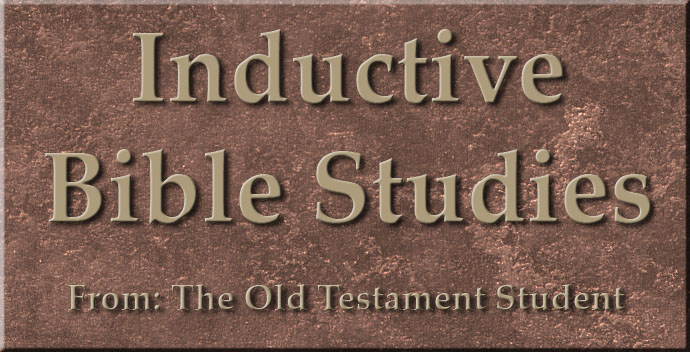
Inductive Bible Studies,
[Copyright by W. R. HARPER, 1887.]
PREPARED BY PROFESSORS W. R. HARPER (Yale University), W. G. BALLANTINE (Oberlin Theol. Sem.), WILLIS J. BEECHER (Auburn Theol. Sem.), and G. S. BURROUGHS (Amherst College).
|
Twenty-Fifth Study.—The Prophecy of Joel. [The material of this " study " is furnished by Professors Burroughs. It is edited by Professor Harper.]
I. PRELIMINARY NOTES. 1. Having completed the study of the written prophecy of the northern kingdom,-considered in its progressive character and yet viewed as a unit,-we are now prepared to advance to the study of written prophecy in Judah. 2. In so doing, we should note carefully the special characteristics of this prophecy, as distinguished from that of the ten tribes, viz.,as standing in relation to and conditioned by
3. Special attention, therefore, should be given to the study of Messianic prophecy, as developed, in the progress of general prophecy, in the southern kingdom and disclosed in its written forms, e. g., in particular, its positive, explicit and personal character. 4. The prophecy of Joel may well be regarded as the point of departure in this southern prophecy, and as containing, both negatively and positively, the germs found more fully developed in its subsequent manifestations. II. BIBLICAL LESSON.1 1. Read, slowly and carefully, using the Revision, the prophecy of Joel. Note any expressions which are not clear to you. Guided by the impressions gained from this reading, answer, tentatively and only so far as you can clearly do so, the following questions:
2. Re-read 1:1-2:17. Consider the following questions:
3. Re-read 2:18-3:21. Consider the following matters:
4. Make a special study of 2:28,29.
5. Make a special study of 2:30-32. (1) How closely are the phenomena of vv. 30,31 to be defined? (2) What is the basis or personal condition of deliverance in " Jehovah's Day "? See v. 32a; cf. Gen. 4:26; 12:8; 13:4; 21:33; Micah 4:5; Zech. 10:12. (3) How is "Mount Zion" regarded in 32b; compare Obad. 17. (4) Who are those "whom Jehovah doth call"? Are the heathen here spoken of? (5) Note the N. T. use of this passage, Acts 2:19-21; Rom. 10:13. 6. Make a special study of 3:1-21. (1) "The valley of Jehoshaphat" (vv. 2,12), meaning ? Is this an ideal valley, or has the prophet a definite location in mind, and, if so, what? What historical occurrence may lie at the basis of the scene? See 2 Chron. 20:14-30. (2) What is the figure here used to represent the divine judgment? Cf. Isa. 63:1-6; Matt. 3:12; 13:30, 39-43; Rev. 14:15-20, etc. (3) What is the result of this judgment? See vv. 18-21. How is the blessing of Judah represented? (4) Meaning of v. 21? Is there here a divine removal of blood-guiltiness and a divine purification, which render possible the height of blessing, viz. the permanent divine fellowship? 7. As the conclusion of the above study
III. SPECIAL TOPICS. 1. Date of the Prophet.
2. The Style of the Prophet.
3. Comparisons as to Religious Worship and Conceptions of God. (1) Compare the view of the divine worship afforded by the book of Joel with that disclosed in Amos and Hosea.6 How do you account for the difference? (2) Compare the view of the divine character given in the prophecy of Joel with that of
Consider these conceptions of Jehovah in connection with the national character of Israel and Judah, as disclosed in these several books. 4. Comparisons as to Messianic Prophecy. Contrast the Messianic prophecy found in the writings of Amos and Hosea, of the northern kingdom, with that found in Joel. Show how these contrasts stand related to contrasted national circumstances, religious character and divine mission.
|
|
 |
 |
|
1) The following literature may be noted; Briggs, "Messianic Prophecy," pp. 153-160; von Orelli, "O. T. Prophecy," pp. 191-196, 204-223; Ewald, "Prophets of O. T.," vol. 1, pp. 107-142; Delitzsch, "O. T. Hist. of Redemption," p. 112 seq.; "Messianic Prophecies," p. 110; Keil and Delitzsch, "Minor Prophets," Joel, C. F. Keil, vol. 1, pp. 169-232; Schaff, "Lange's Conm," Joel, O. Schmoller and J. Forsyth; Geikie, "Hours with the Bible," vol. 4, pp. 154-164; attention is also called to "The Prophecy of Joel; Its Unity, its Aim and the Age of its Composition," W. L. Pearson, Liepzig, T. Stauffer, 1885. 2) See, especially, von Orelli, pp. 205-209. 3) See 2 Kgs. 8:20; 2 Chron. 21:16,17; also, consult " study " twentieth, V. 2, 3. 4) See " studies " twenty-third and twenty-fourth. 5) See Ewald, "Prophets of O. T.," vol. 1, pp. 109-114. 6) See " studies" twenty-third and twenty-fourth.
|
|
-
Site Navigation
 Home
Home What's New
What's New Bible
Bible Photos
Photos Hiking
Hiking E-Books
E-Books Genealogy
Genealogy Profile
Free Plug-ins You May Need
Profile
Free Plug-ins You May Need
 Get Java
Get Java.png) Get Flash
Get Flash Get 7-Zip
Get 7-Zip Get Acrobat Reader
Get Acrobat Reader Get TheWORD
Get TheWORD